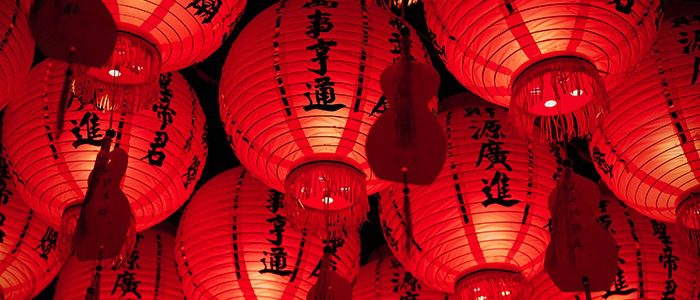Chinese Colors and What They Symbolize
Many people are familiar with the important symbolism of the color red in Chinese culture, but are you familiar with the symbolism of other colors?
Traditionally, red, black, qing (blue/green), white, and yellow are standard colors and represent the five elements of fire, water, wood, metal, and earth. Let’s learn about the meanings and associations of colors in Chinese to help gain a deeper and more “colorful” (pun intended) understanding of the language and culture.
Chinese Colors and Their Meanings in Chinese Culture
Lucky Red

Let’s start with the most popular and prominent color in Chinese culture—red (紅, hóng).
When you think of Chinese New Year you think of red envelopes, red lanterns, red is everywhere. It symbolizes good luck and is traditionally a happy color, therefore strictly prohibited at funerals. Brides do wear red to ward off evil though.
Red is such a vibrant and powerful color, it also symbolizes vitality, celebration, and fertility. Keep in mind, too, that when you’re picking up a pen to write a note or sign a card, be careful NOT to use red ink, because red ink is known to be used when writing the names of the dead. Naturally, red is associated with the element of fire.
Black is King in Chinese Color Symbolism
Interestingly, black (黑, hēi) corresponds with the element of water. While red is probably the most popular color, ancient Chinese people considered black the king of colors. However, today, it is associated with destruction, evil, disasters, and cruelty. The Chinese word for black, hēi, stands for bad luck, irregularity, and illegality.
Qing (Green/blue)
(Green jade pendant with the word for fortune or good luck 福 (fú)).
Qing (青, qīng), can be green or blue, depending on what noun it is associated with. For example, the word for sky is 青天 (qīng tiān), which then means sky blue. However, the color is more often associated with green, such as the words for grass, 青草 (qīng cǎo), green mountains, 青山 (qīng shān), and green vegetables, 青菜 (qīng cài). It represents the element of wood and is associated with health, prosperity, and harmony. Think of the popularity and wide use of jade, that is highly valued.
There are, however, specific words for green and blue. Green is 綠 (lǜ) and blue is 藍, (lán).
Pure White
Contrary to western culture, white, 白(bái), is associated with death and mourning. So while in western culture it is common to wear black whilst in mourning, in ancient Chinese culture people wore white. White is associated with the element of metal, and therefore, despite its association with death and mourning, it also represents brightness, purity, and fulfilment.
Yellow, the Most Beautiful Color of Them All in Chinese Culture

(The Yellow River, 黃河, huáng hé)
Yellow, 黃 (huáng) is the earth and is also a very popular color, probably seen and used as much as red, because it is considered the most beautiful and prestigious color.
It is considered to generate Yin and Yang, meaning that yellow is the center of everything. It was once the emperor’s color and is symbolic of the five legendary emperors of ancient China, the Yellow Emperor, Zhuanxu, Emperor Ku, Emperor Yao, and Shun. You will often find yellow in royal palaces, altars, temples, and also the emperor’s robes and attire.
However, today the color yellow has developed an association with pornography. For example, the color yellow (黃色, huáng sè), combined with the word for movie (電影, diàn yǐng) in Chinese, becomes pornographic movie .
Some Chinese Color Grammar
Typically when writing Chinese colors you write the color and add the literal word for color, 色(sè). It’s basically like saying ___-colored.
Red – 紅色, hóng sè (red-colored).
Black – 黑色, hēi sè (black-colored)
Qing – 青色, qīng sè (green/blue-colored)
Green – 綠色, lǜ sè (green-colored)
Blue – 藍色, lán sè (blue-colored)
White – 白色, bái sè (white-colored)
Yellow – 黃色, huáng sè (yellow-colored)
If you want to describe a mixed color like blueish-green, you would just combine the colors and say 藍 綠色 (lán lǜ sè)
When using color as a adjectives to describe a objects, start with the color and add the structural particle 的 (de). So, if you want to describe the house as red, you would say 紅色 的 房子 (hóng sè de fáng zi). However, you can also drop the 色 (sè) and 的 (de), and just say 紅 房子 (hóng fáng zi). Both ways are correct.
Learn Chinese Faster Using LingQ
Immersing yourself in Chinese doesn’t require you to travel abroad or sign up for an expensive language program.
However, it can be a bit tiresome to find interesting content, go back and forth between sites, use different dictionaries to look up words, and so on.
That’s why there’s LingQ. A language app that helps you discover and learn from content you love.

You can import videos, podcasts, and much more and turn them into interactive lessons.
Keep all your favourite Chinese content stored in one place, easily look up new words, save vocabulary, and review. Check out our guide to importing content into LingQ for more information.
LingQ is available for web as well as Android and iOS. Gain access to thousands of hours of audio and transcripts and begin your journey to fluency today. Check out LingQ to discover how to learn Chinese!
***
Justine Wentzell is a writer based in Los Angeles, with a love for learning languages. As a native Angeleno and daughter of immigrants, she grew up learning Mandarin and Spanish, and studied Russian at university.


